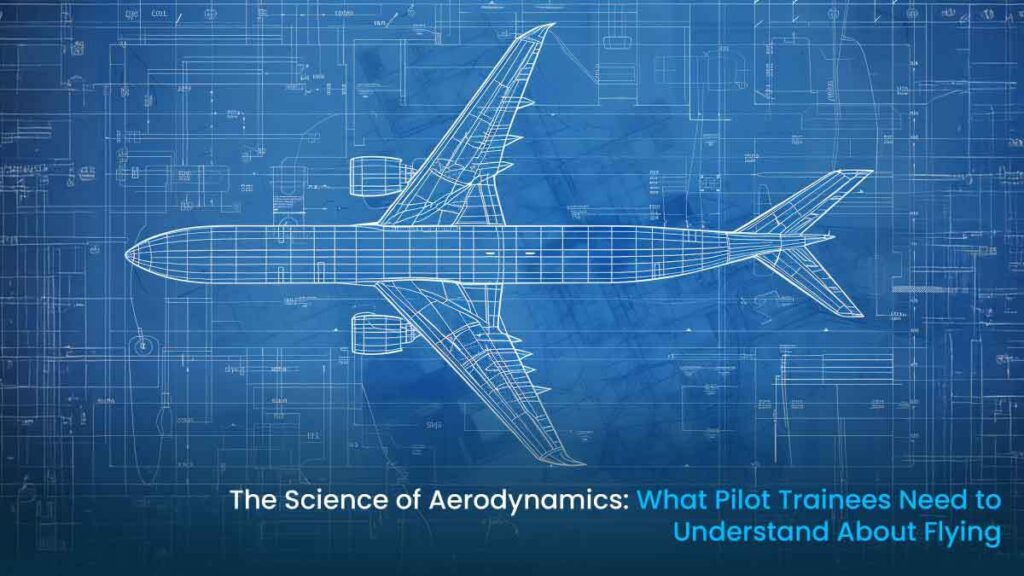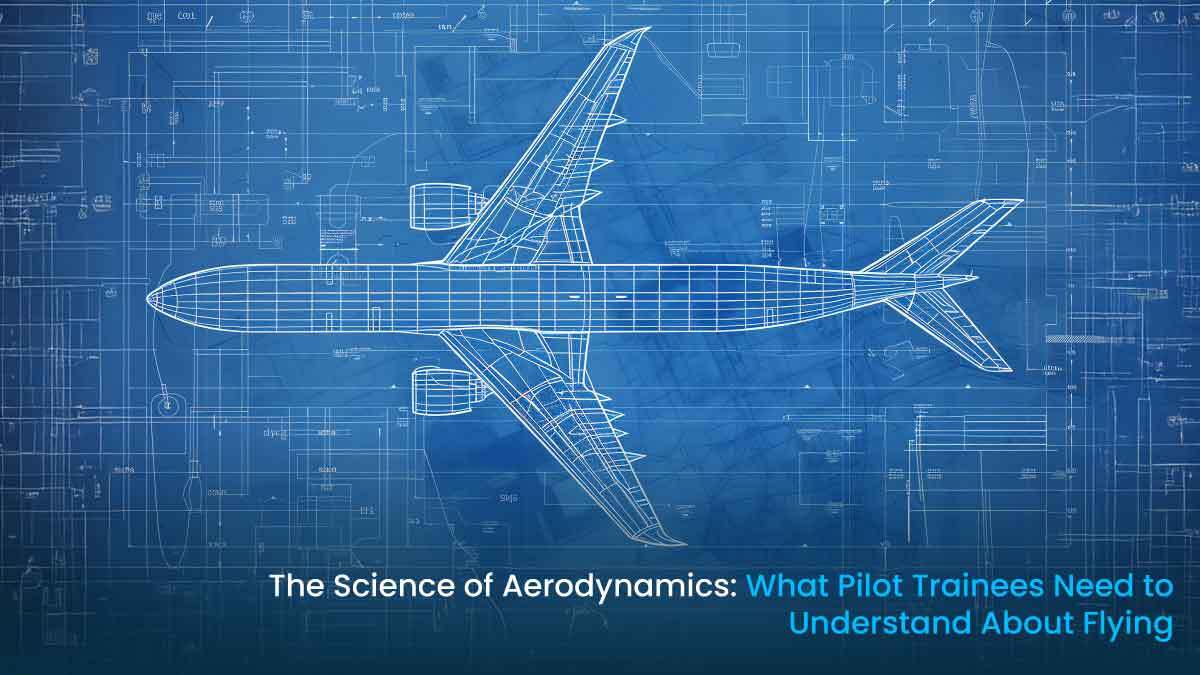
An aircraft pilot requires three elements to operate a plane successfully: skilful technique; scientific comprehension; and an added ability to master the natural aerodynamic forces. Understanding aerodynamics is an essential requirement for trainee pilots learning to control aircraft flight. Modern aircraft use sophisticated technology, yet aerodynamic laws continue to control their operational behaviour.
The essential principles that explain how aircraft navigate are explained through this blog:
What is Aerodynamics?
The field of aerodynamics examines how moving airborne bodies interact with air currents. Aerodynamics controls all the fundamental aspects of flight, which allows aircraft to take off, maintain altitude and achieve a safe landing. Learning aerodynamics as principles becomes essential because these forces determine how aircraft behave in flight.
The Four Forces of Flight
Every aircraft in flight is subjected to four fundamental forces:
- Lift: This is the force that opposes gravity and allows an aircraft to rise into the sky. Lift is generated by the wings as air flows over and under them.
- Weight (Gravity): The downward force exerted by Earth’s gravity, which must be overcome by lift for an aircraft to take off.
- Thrust: The forward force produced by the aircraft’s engines or propellers that moves the plane through the air.
- Drag: The resistance an aircraft experiences as it moves through the air. Pilots must manage drag to ensure efficient flight.
For an aircraft to stay in level flight, lift must equal weight, and thrust must balance drag. If any of these forces become unbalanced, the aircraft will either climb, descend, or change speed.
How Lift is Generated
Lift is created due to the shape of an aircraft’s wings, known as an aerofoil. The aerofoil’s design enables air to move faster over the top surface and slower underneath. According to Bernoulli’s Principle, faster-moving air has lower pressure than slower-moving air. This pressure difference creates an upward force—lift—that allows an aircraft to rise into the sky.
However, lift is not just about wing shape. The angle of attack, airspeed, and air density all influence how much lift is produced. Pilots must be aware of these factors to maintain controlled flight and avoid situations like stalls, where lift is lost due to excessive angle of attack.
Thrust and Drag: The Balance of Forward Motion
Thrust and drag work in opposition. While thrust moves an aircraft forward, drag works against it. Pilots can control thrust using throttle inputs, increasing power to gain speed or reducing it to slow down. Drag, on the other hand, can be minimised by streamlined aircraft designs and proper control surface management.
There are two main types of drag:
- Parasite Drag: Caused by the shape and surface of the aircraft, including friction from the fuselage, landing gear, and other non-lifting surfaces.
- Induced Drag: Generated as a byproduct of lift, occurring when air flowing over the wings creates vortices at the wingtips.
To fly efficiently, a pilot must manage both types of drag while ensuring sufficient thrust is available to maintain the desired speed and altitude.
Stability and Control
For safe flight, an aircraft must maintain stability and respond predictably to pilot inputs. There are three main axes around which an aircraft moves:
- Pitch (Lateral Axis): Controlled by the elevator, pitch determines whether the nose of the aircraft moves up or down.
- Roll (Longitudinal Axis): Managed by the ailerons, roll causes the aircraft to tilt left or right, essential for turning.
- Yaw (Vertical Axis): Controlled by the rudder, the yaw adjusts the direction the nose is pointing without rolling the aircraft.
Pilots use these control surfaces in combination to manoeuvre the aircraft smoothly and maintain stability in various flight conditions.
The Role of Airspeed and Altitude
Airspeed and altitude play a vital role in flight performance. An aircraft must maintain a proper airspeed range to ensure sufficient lift and prevent stalls. Flying too slow can cause a loss of lift, while excessive speed may lead to structural stress. Similarly, altitude affects air density, which influences lift and engine performance. Higher altitudes have thinner air, requiring pilots to adjust their flying techniques accordingly.
Understanding Stalls and Spins
A stall occurs when an aircraft’s wings can no longer generate enough lift due to an excessive angle of attack. This is a critical situation that every pilot must learn to recover from. If a stall is not corrected, it can lead to a spin, where the aircraft spirals downward uncontrollably. Pilots are trained to recognise early stall warnings and take corrective actions, such as reducing the angle of attack and increasing thrust to regain lift.
Conclusion
Understanding the aerodynamics of flight is essential for every trainee pilot. By mastering the fundamentals of aerodynamics, pilots gain the knowledge needed to control an aircraft safely and efficiently. Whether it’s balancing lift and weight, managing thrust and drag, or ensuring stability through the principles of aerodynamics, a pilot’s ability to interpret and respond to these forces is key to a successful flight. The law of aerodynamics governs every movement an aircraft makes, making it a critical area of study for anyone aspiring to take to the skies. By building a strong foundation in aerodynamics, pilots can navigate the challenges of flight with confidence and skill.
FAQs
Q. What is aerodynamics, and why is it important for pilots to understand?
A. Aerodynamic exploration describes how air interacts with objects during flight but focuses heavily on aircraft behaviour. Learning aerodynamics proves crucial for pilots because it reveals fundamental flight principles, steering methods, and aviation risk reduction strategies.
Q. What is drag, and how can pilots minimize it?
A. Plane speed reduction originates from drag, which matches air friction during flight. Reducing drag requires pilots to maintain their planes in a streamlined position while minimising turbulence and deploying flaps exactly as instructed.
Q. How do turbulence and air currents affect flight?
A. Aircraft experience turbulence from bumpy air conditions and encounter air currents similar to riverlike winds. Pilots must master the techniques needed for safe navigation through areas where aircraft experience unexpected movements and shaking.
Q. How do different weather conditions affect aerodynamics?
A. Things like rain, snow, and temperature can change how the air behaves and how the plane flies. Pilots need to adjust their flying based on the weather.
Q. How can pilot trainees improve their understanding of aerodynamics?
A. They can study books and articles, use flight simulators, talk to experienced pilots, and pay attention to how the plane feels during flights.

